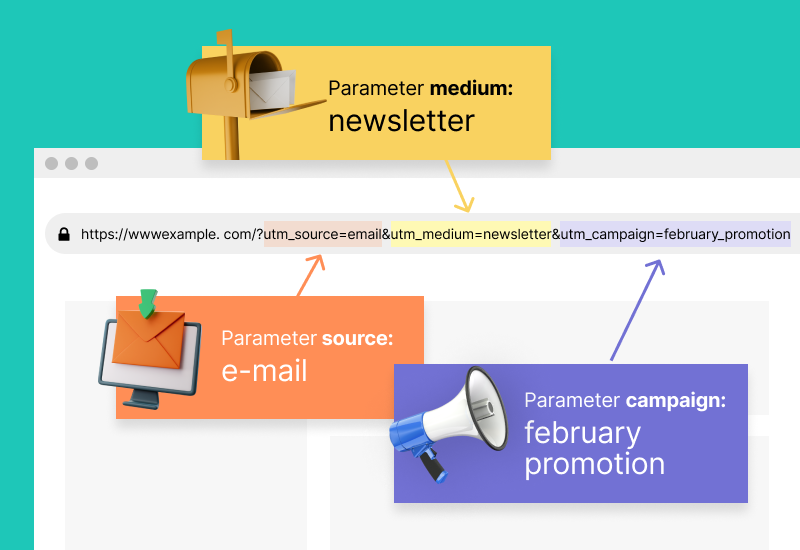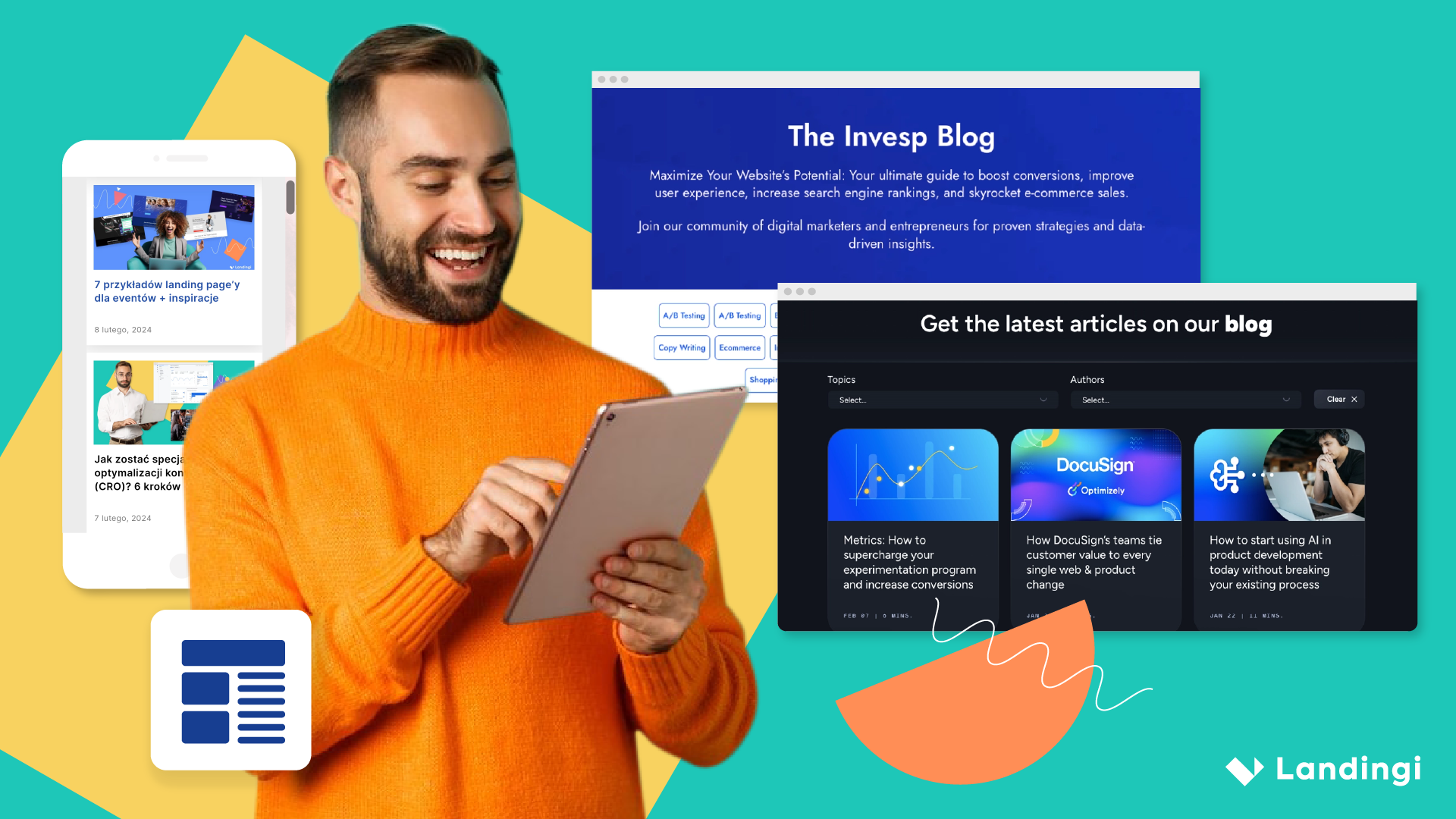If you are starting your adventure with landing pages and online campaigns, you may be a stranger to the concept of UTMs. Below I will try to explain – as simply as possible – what it is, how you can use it, and most importantly, how you can benefit from using UTMs.
For those of you who prefer to watch than read, we have also prepared a short webinar about UTMs – click here to watch it.
Make your sections smartable and let go of mundane manual tasks with Smart Sections! An easy way to manage bulk changes.
What are UTM parameters?
UTM parameters, also known as UTM codes, are tags that are added to URLs to track traffic sources and campaign performance. These tags allow marketers to see where their website visitors are coming from and how they interact with their site, providing valuable insights into the effectiveness of their marketing campaigns. In this article, we will discuss why it is a great idea to use UTM parameters in links and how they can help optimize lead-generation campaigns.
One of the primary benefits of UTM parameters is the ability to track the performance of online campaigns accurately. By adding UTM tags to links in emails, social media posts, and advertisements, marketers can see exactly how many clicks each campaign generates and where those clicks are coming from. This information can be used to make informed decisions about where to allocate resources and which campaigns to optimize.
Another benefit of UTM parameters is that they allow marketers to understand their target audience better. By tracking which sources drive the most traffic and conversions, marketers can gain a deeper understanding of which channels are the most effective for reaching their target audience. This information can then be used to tailor future campaigns better to meet the needs and preferences of their audience.
Imagine you wish to direct traffic to your landing page from more than one source. Of course, you would wish to know which customer came from where. One way of doing it is to create a few versions of the same page and use different links in different places on the web. You can do that, but with an additional personalization of each version in mind – click here to find out, why it makes sense to personalize the landing pages. But if you just wish to correlate a client with a source, this is an unnecessary hassle. Instead, you can use one page, the same page, and the same link, with only UTM parameters – specific for each source added.
Get 111 Landing Page Examples—The Ultimate Guide for FREE
UTMs & lead generation campaigns
Using UTM parameters with landing pages is particularly beneficial for lead-generation campaigns. Landing pages are designed to capture leads and convert them into customers, and UTM parameters can help optimize this process by tracking which sources are driving the most conversions. This information can be used to fine-tune landing pages and improve conversion rates, helping to maximize the return on investment of a lead generation campaign.
In conclusion, UTM parameters are a powerful tool for marketers looking to optimize their online campaigns and generate more leads. By providing valuable insights into the performance of campaigns and the behavior of their target audience, UTM parameters can help marketers make informed decisions and improve their lead-generation efforts. Whether you are a seasoned marketer or just starting, incorporating UTM parameters into your online campaigns is a great idea that can help drive success.
How those UTMs look like?
UTM tracking works by adding tags (also called UTM parameters) to the end of a URL. When someone clicks on a link with UTM parameters, the tags are sent to the website and recorded in analytics tools, such as Google Analytics. Please note that Landingi forms can automatically collect UTM information from links.
The UTM parameters provide information about the traffic source, such as the email campaign, social media platform, or advertising network, as well as the specific content, such as the email subject line or advertisement headline.
Here is an example of a URL with UTM parameters:

These UTM parameters tell the website and analytics tool that the traffic came from an email newsletter and that the specific campaign was the February promotion. And as I wrote above, it can also be automatically collected by our form and added to lead details.
You can pass UTM parameters from your landing page to another URL address after clicking a button. Read how to configure forwarding UTMs to another URL to keep tracking conversions in your landing page Dashboard.
Once the data is collected, you can use analytics tools to see how their campaigns are performing and make informed decisions about how to optimize them. For example, you can see which sources are driving the most traffic, which campaigns are generating the most conversions, and which content is resonating with their target audience. It will also help you check which source collected leads have the most value. This information can be used to fine-tune campaigns, allocate resources more effectively, and improve overall marketing performance.
In summary, UTM tracking works by adding parameters to URLs that provide information about the source and content of the traffic. When someone clicks on a link with UTM parameters, the data is collected and used to inform marketing decisions and optimize campaigns.
Should you use UTM parameters?
Yes, UTM parameters should be added to links in online ads. As you just read above, it may help you on many levels. From fine-tuning your campaign to evaluating costs and comparing the actual lead value depending on the source. Perhaps, after a while, you will see that customers gained from source A (although it was more expensive) bring you a lot more value than those collected for less from source B.
UTM in Google Analytics? No problem!
To set up UTM tracking in Google Analytics, follow these steps:
- Log in to your Google Analytics account and select the website you want to track.
- Go to the Admin section and select “Property Settings.”
- Scroll down to the “Default URL Query Parameters” section and add the UTM parameters you plan to use in your campaigns.
- Once you have set up the UTM parameters in Google Analytics, you’ll be able to track the performance of your campaigns in the “Acquisition” section of the dashboard.
- To compare the performance of different campaigns, you can create custom reports or use the built-in “Campaigns” report in Google Analytics. In this report, you’ll be able to see the total number of clicks and conversions generated by each campaign, as well as other important metrics, such as the average time on site and bounce rate.
For more detailed information and support, I would refer you directly to Google.
Even more about UTM in forms
As for adding UTM collection fields in forms, it is unnecessary to do so, as the UTM parameters are automatically passed along in the URL when someone clicks on a link with UTM parameters.
However, if you want to capture the UTM parameters in a form, you can simply add specific, hidden fields in the Landingi form. It is a super easy thing to do – check our guide on UTMs. This way, you’ll have a record of the UTM parameters for each form submission, which can be useful for tracking lead-generation campaigns.
In conclusion, setting up UTM tracking in Google Analytics is a simple process that can provide valuable insights into the performance of your online campaigns. By tracking and comparing the performance of different campaigns, you can make informed decisions about how to optimize your marketing efforts and improve the ROI of your advertising budget.
Are there any cons of using UTMs?
Yes, there are some potential drawbacks to using UTM parameters:
- Complexity: UTM parameters can add complexity to your tracking setup, particularly if you’re running multiple campaigns with different sources and mediums. This can make it difficult to keep track of which campaigns are generating the most traffic and conversions.
- URL length: Adding UTM parameters to a URL can make it longer and less aesthetically pleasing. This can be a disadvantage when sharing links on social media, where character limits are often in place.
- Data accuracy: UTM parameters rely on manual setup and implementation, so there is a risk of incorrect implementation or incorrect data being recorded. This can lead to inaccurate tracking data and a skewed view of campaign performance.
- Limited data collection: UTM parameters only collect data related to the specific campaigns they are tracking. This means that they may not provide a comprehensive view of overall website traffic and behavior.
Overall, while UTM parameters can provide valuable insights into campaign performance, it’s important to weigh the potential drawbacks against the benefits when deciding whether to use them.
Is there a better alternative to UTMs?
Yes, there are alternative tracking methods to UTM parameters. Just to list a few, those are:
- Google Tag Manager
- Custom tracking codes
- Direct integration with advertising platforms
Ultimately, the best alternative to UTM parameters will depend on the specific needs of your tracking setup and the tools and platforms you’re using for your online advertising campaigns. Consider your tracking requirements and the capabilities of different tracking methods to determine which approach is best for you. It also seems that the UTM is the easiest and the most straightforward to use. Especially if you are not advanced with the knowledge of analytical tools and similar.
To summarize the above in a few words
If you are not an Analytics and GTM guru or do not have someone to help you, use UTM. Always, when you run a lead generation campaign. Especially if in more than one source. But even if not, having additional insight into where the client came from can prove to be invaluable. UTM parameters can provide valuable insights into campaign performance, but they may not be the best approach for all tracking setups.







